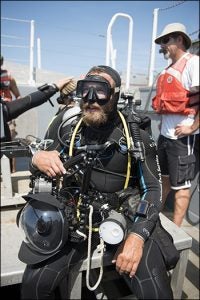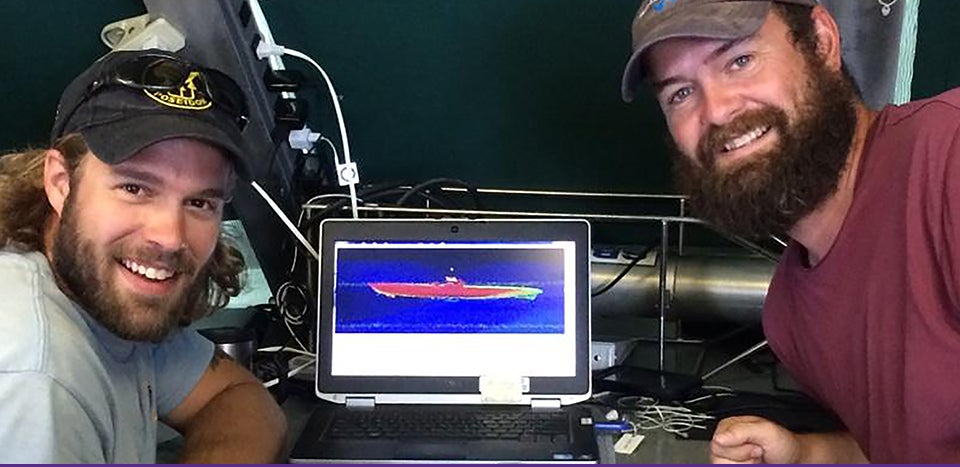‘FORGOTTEN STORIES’
ECU-trained scientists discover Battle of the Atlantic shipwrecks
Two East Carolina University alumni were the principal investigators in the Oct. 21 discovery of two shipwrecks from an important World War II naval battle off the North Carolina coast.
Joe Hoyt and John Bright led a team of divers and scientists from the National Oceanic and Atmospheric Administration (NOAA) in identifying the remains of the freighter Bluefields and the German submarine that sank it. Hoyt and Bright are recent graduates of ECU’s master’s in underwater archaeology program.

ECU alumnus John Bright prepares to dive during the search for the shipwrecks. (Photo by John McCord, Coastal Studies Institute)
The ships went down on July 15, 1942 about 30 miles off Cape Hatteras during the storied Battle of the Atlantic phase of the war. Their discovery culminated a five-year-long NOAA project to survey and document vessels lost during WWII off the North Carolina coast.
ECU and the UNC Coastal Studies Institute were partners in the project with NOAA and the Bureau of Ocean Energy Management. Dr. Nathan Richards, an associate professor in ECU’s maritime studies program, and other ECU students assisted Hoyt and Bright.
“It was pretty exciting,” Hoyt said about the discovery. “I was really happy for John because he had worked on (new mapping technology used to detect such underwater artifacts) as part of his master’s thesis. We have been working on this for five years and having all that work pay off is a great feeling – it’s hard to describe.”
The Bluefields was in a group of 19 merchant ships being escorted by the U.S. Navy and Coast Guard from Norfolk, Virginia, to Key West, Florida, to deliver cargo to aid the war effort. The German submarine U-576 attacked the convoy, sinking the Bluefields and severely damaging two other ships. U.S. Navy Kingfisher aircraft then bombed the U-576.
The crew of the Bluefields was rescued without any casualties. The 45-man crew of U-576 was lost.
Efforts to locate the shipwrecks were the focus of a 2013 National Geographic TV documentary, “Hitler’s Secret Attack on America.”
“This is not just the discovery of a single shipwreck,” said Hoyt, a NOAA sanctuary scientist. “These two ships rest only a few hundred yards apart and together help us interpret and share their forgotten stories.”
The discovery is a window into the underwater battlefield landscape of WWII, said David Alberg, superintendent of NOAA’s Monitor National Marine Sanctuary.
“Most people associate the Battle of the Atlantic with the cold, icy waters of the North Atlantic,” Alberg said. “But few people realize how close the war actually came to America’s shores.”
Hoyt said it should not be surprising that ECU played a key role in the discovery. “The ECU diving program is one of the best there is in the country, the world even.”
